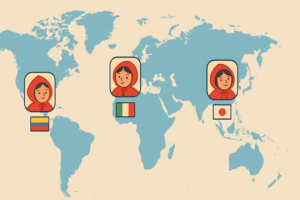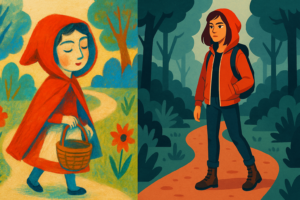Once upon a time, in an enchanted forest, there was a little girl with a red hood and a wolf with a suspiciously wide smile! For centuries, the story of Little Red Riding Hood has captivated children and adults alike—not just for its suspense and moral lesson, but for its ability to evolve with time while preserving its essence. But what makes this story so fascinating? Join us on a journey through time, culture, and creativity to discover why Once Upon a Forest: Discover the Magic of Little Red Riding Hood is far more than a children’s tale.
The Legendary Origin of Little Red Riding Hood
The tale of Little Red Riding Hood, also known as “Le Petit Chaperon Rouge” in French, first appeared in written form in the 17th century. Charles Perrault was the first to publish it, although oral versions were already widespread throughout Europe. Later, the Brothers Grimm included it in their famous collection of German folktales, giving it a less grim ending and introducing the character of the heroic woodsman.
Perrault’s version carried a clear moral: beware of talking to strangers, particularly for young girls. The Grimms softened the message, transforming the tale into a gentler yet still impactful warning.
Iconic Characters and Their Symbolic Meanings

Little Red Riding Hood
She symbolizes innocence, childhood, curiosity, and also disobedience. Her distinctive red cloak has been interpreted as a symbol of transition—from girl to woman, from ignorance to knowledge.
The Big Bad Wolf
More than just a villain, the wolf represents worldly dangers and deceptive cunning. In some modern interpretations, the wolf even symbolizes manipulative figures in society.
Grandmother and the Woodsman
The grandmother embodies ancestral wisdom and intergenerational connection. The woodsman, introduced in later versions, acts as the guardian angel who arrives just in time.
Discover our illustrated version of Little Red Riding Hood and bring the magic of the forest into your home or classroom.
Cultural Variations of the Tale
The story has traveled the world, taking on unique adaptations:
- In Japan, a magical fox saves the girl.
- In Italy, “La finta nonna” (The Fake Grandmother) presents a more grotesque, humorous tone.
- In Latin America, versions have emerged with morals focused on community or nature.
These variations reflect local cultural concerns, adapting the essence of Little Red Riding Hood to different social contexts.

Key Lessons from the Tale
The story of Little Red Riding Hood not only entertains but educates. Among the most important lessons are:
- Don’t talk to strangers: A foundational childhood rule.
- Listen to your elders: The mother’s warning not to stray is crucial.
- Things aren’t always what they seem: The wolf uses sweet words to deceive.
These lessons are backed by educators and child psychologists as valuable tools for emotional learning.
Little Red Riding Hood Through the Media
From illustrated books to animated films and video games, Little Red Riding Hood has had countless reinventions. Modern versions often depict her as a brave heroine, breaking free from the damsel-in-distress archetype.
A study by the University of Granada (2021) found that classic tales adapted to new narratives increase children’s reading engagement by 43% compared to standard informative texts.

Applications at Home and in the Classroom
- Shared reading: Parents and kids can read together and discuss what they would do if they were in Little Red’s shoes.
- Roleplay and dramatization: Perfect for theater or language arts classes.
- Create new versions: Encourage children to change the ending or characters.
These activities reinforce expression, creativity, and critical thinking skills.
Conclusion: A Tale That Still Walks the Forest Path
Little Red Riding Hood remains one of the most powerful and versatile tales in children’s literature. Its simplicity is deceptive, hiding deep lessons and vast pedagogical potential. If you haven’t yet explored its illustrated versions, educational applications, or modern retellings—now is the time.






+ There are no comments
Add yours